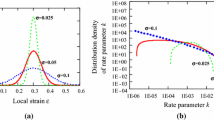Abstract
A series mathematical model has been developed for the prediction of flow stress and microstructure evolution during the hot deformation of metals such as copper or austenitic steels with low stacking fault energies, involving features of both diffusional flow and dislocation motion. As the strain rate increases, multiple peaks on the stress-strain curve decrease. At a high strain rate, the stress rises to a single peak, while dynamic recrystallization causes an oscillatory behavior. At a low strain rate (when there is sufficient time for the recrystallizing grains to grow before they become saturated with high dislocation density with an increase in strain rate), the difference in stored stress between recrystallizing and old grains diminishes, resulting in reduced driving force for grain growth and rendering smaller grains in the alloy. The final average grain size at the steady stage (large strain) increases with a decrease in the strain rate. During large strain deformation, grain size reduction accompanying dislocation creep might be balanced by the grain growth at the border delimiting the ranges of realization (field boundary) of the dislocation-creep and diffusion-creep mechanisms.
Similar content being viewed by others
References
N. E. Dowling, Mechanical Behavior of Material (Pren-tice Hall, Englewood Cliffs, NJ, 1993).
A. K. Mukgerjee and R. H. Mishra, “Creep mechanism in dispersion strengthened materials,” Proc. The Johannes Weertman Symposium, TMS, Warrendale, PA, 119, 111–121 (1996).
R. L. Goetz and V. Seetharaman, “Modeling dynamic recrystallization using cellular automata,” Scr. Mater. 38, 405–413 (1998).
R. Ding and Z. X. Guo, “Coupled quantitative simula-tion of microstructural evolution and plastic flow dur-ing dynamic recrystallization,” Acta Mater. 49, 3163–3175 (2001).
J. H. P. De-Bresser, J. P. J. Reijs, and C. J. Spiers, “On dynamic recrystallization during solid state flow: Effects of stress and temperature,” Geophys. Res. Lett. 25, 3457–3460 (1998).
S. S. Dmytro, “The coupled model of a microstructure evolution and a flow stress based on the dislocation the-ory,” ISIJ Int. 45, 1187–1193 (2005).
F. Grosman, “Application of a flow stress function in programmes for computer simulation of plastic working processes,” J. Mater. Process. Techn. 64, 169–180 (1997).
C. Roucoules, M. Pietrzyk, and P. D. Hodgson, “Anal-ysis of work hardening and recrystallization during the hot working of steel using a statistically based internal variable model,” Mater. Sci. Eng., A 339, 1–9 (2003).
E. J. Mittemeijer and F. Sommer, “Solid state phase transformation kinetics: A modular transformation model,” Z. Metallkd. 93, 352–361 (2002).
W. Roberts, Deformation Processing and Structure (ASM, Metals Park, OH, 1984), pp. 109–121.
U. F. Kocks, “Laws for work-hardening and low-tem-perature creep,” J. Eng. Mater. Technol. 98, 76–85 (1976).
I. R. Epstein, “Differential delay equations in chemical kinetics: Some simple linear model systems,” J. Chem. Phys. 92, 1702–1712 (1990).
L. Zhang, W. Yang, and Z. Sun, “Modeling of micro-structural evolution during dynamic recrystallization in coarse Nb microalloyed austenite,” J. Univ. Sci. Techn. Begin. 14, 130–135 (2007).
V. G. Garcia, J. M. Cabrera, and J. M. Predo, “Predict-ing multiple peak dynamic recrystallization of copper,” Mater. Sci. Forum 467, 1181–1186 (2004).
A. P. Singh, D. Sengupta, G.M.D. Murthy, S. Jha, M. P. Yallasiri and N. S. Mishra, “A mathematical model to predict microstructural changes and final mechanical properties of API-grade steel plates pro-duced by thermomechanical control processing,” Proc. 44th Mech. Working Steel Proc. Conf. Warrendale, PA, 2002, pp. 1139–1141.
W. A. Johnson and R. F. Mehl, “Reaction kinetics in processes of nucleation and growth,” TMS–AIMME 135, 416–458 (1939).
J. H. P. De-Bresser, J. H. Ter-Heege, and C. J. Spiers, “Grain size reduction by dynamic recrystallization: Can it result in major rheological weakening?” Int. J. Earth Sci. 90, 28–45 (2001).
E. H. Rutter, “Experimental study of the influence of stress, temperature, and strain on the dynamic recrys-tallization of carrara marble,” J. Geophys. Res. 100, 24651–24663 (1995).
H. J. McQueen and B. Baudelet, “Comparison and contrast of mechanisms, microstructures, ductilities in superplasticity and dynamic recovery and dynamic recrystallization,” in Strength of Metals and Alloys (Proc. 5th Int. Conf. on Strength of Metals and Alloys), Ed. by P. Haasen, V. Cerold, and G. Kostorz, (Perga-mon, Aachen, 1980), pp. 329–336.
A. P. Orlova and J. Cadek, “Dislocation structure and applied, effective and internal stress in high-tempera-ture creep of alpha iron,” Philos. Mag. 25, 865–877 (1972).
G. Streb and B. Reppich, “Steady state deformation and dislocation structure of pure and Mg-doped LiF single crystals. II. Etch pit studies of dislocation struc-ture,” Phys. Status Solidi A 16, 493–505 (1973).
O. D. Sherby, “Subgrain formation and boundary strengthening in iron based materials,” J. Iron Steel Inst. 211, 640–646 (1973).
Author information
Authors and Affiliations
Corresponding author
Additional information
The article is published in the original.
Rights and permissions
About this article
Cite this article
Choe, J.I. Constitutive relations for determining the critical conditions for dynamic recrystallization behavior. Phys. Metals Metallogr. 117, 364–370 (2016). https://doi.org/10.1134/S0031918X16040037
Received:
Accepted:
Published:
Issue Date:
DOI: https://doi.org/10.1134/S0031918X16040037




